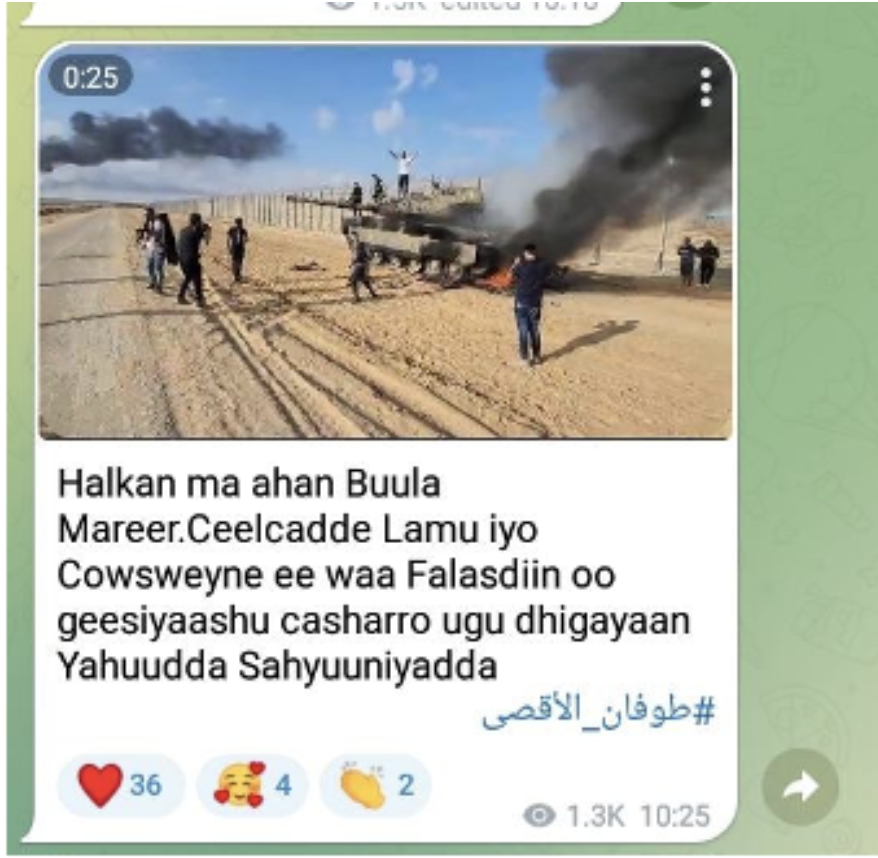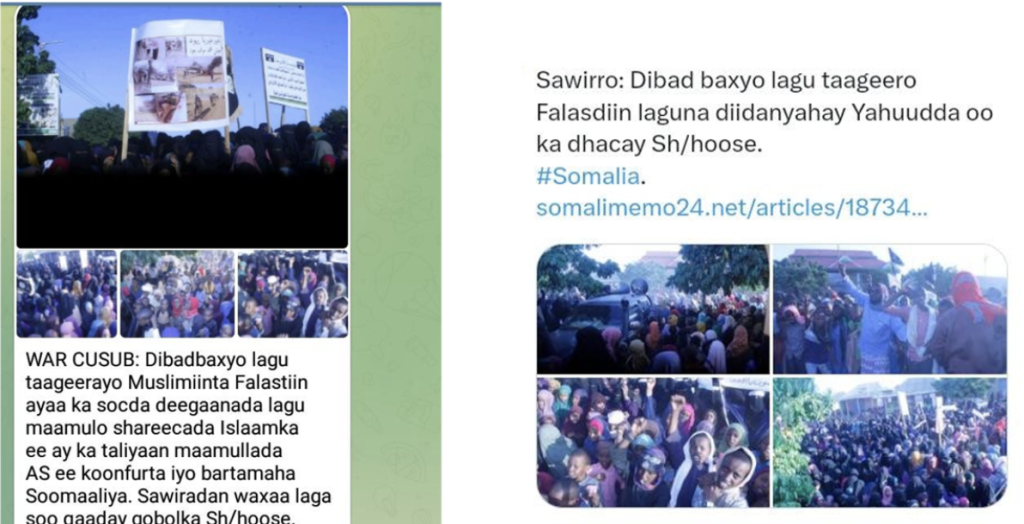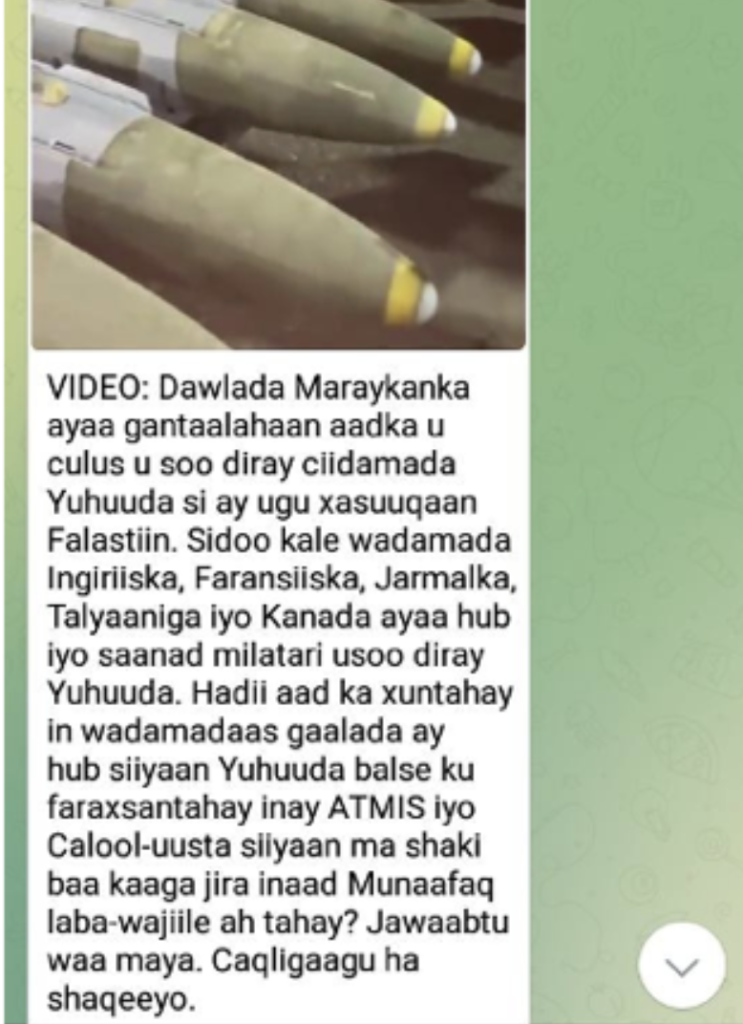Content warning: This Insight contains graphic imagery of war – some images have been blurred.
Introduction
While the world’s focus has turned towards Israel and Gaza, Islamic jihadist groups across the world are seizing upon the violence and hatred circulating on social media to build sympathy for their own causes. Al-Shabaab – a Somali-based terrorist group – in particular has seized upon the Israel-Hamas conflict to embed its own narratives within wider pro-Palestine grievances and build proverbial bridges between the plight of Muslims in both Gaza and in Somalia.
Initially, al-Shabaab used its social media networks to draw parallels between Hamas’ attack and its own fight against ‘colonialism’. In the days following Hamas’ 7 October attack, al-Shabaab networks focused almost exclusively on sharing pro-Hamas content, portraying Hamas as their close ‘brothers’ in the fight against colonial ‘oppressors’. Then, as Israel began its retaliatory bombardment of the Gaza Strip, al-Shabaab saw an opportunity to co-opt wider pro-Palestine narratives to rally a larger audience. The conflict, therefore, presents a dangerous opportunity for al-Shabaab to both incite its base, celebrating Hamas’ ‘victory,’ while also reaching out to wider audiences through the co-option of pro-Palestinian narratives that appeal to many Muslim grievances. Social media, and the chaos of disinformation created by the Israel-Hamas conflict, have allowed al-Shabaab to situate itself within the online battle. It’s not just an external observer, but an active participant in drumming up additional hatred and terror in a way that further propels Hamas’ narratives globally, while also creating opportunities for al-Shabaab to target new recruits.
Inciting the Base
In the days immediately following the 7 October attack by Hamas, al-Shabaab’s networks were alight with congratulatory commentary and reporting of Hamas’ ‘victory.’ The group claimed the victory as a global one for all Muslims fighting against colonial oppression. The images and videos were taken from pro-Hamas news channels, but al-Shabaab influencers framed these images to fit within their own context and battle against colonialism and oppression to resonate with a Shabaab-sympathetic audience. Fig. 1, for example, shows an early image from Hamas, with its militants celebrating around a burning Israel Defence Force (IDF) tank. The al-Shabaab influencer who posted it remarked on the similarity of this image to those taken from al-Shabaab’s own recent victories, where militants posed celebrating on Somali National Army (SNA) tanks. Such a framing allows his audience to immediately grasp onto the image as one of their own, drawing parallels between Hamas’ and al-Shabaab’s victories.

Fig. 1: [approximate translation] “This is not Bula Mareer, El Cadde, Lamu, or Cowsweyne [recent al-Shabaab battles], it is Palestine where the heroes are teaching lessons to the Zionist Jews.”

Fig. 2: Above, a captured IDF soldier [Falastin is Somali for Palestine]. Below, a soldier by al-Shabaab.

Fig. 3: [approximate translation] “Download the Palestine Resistance App and download it to your mobile so that you don’t miss the videos and words about the Al-Aqsa Storm mission. Join the channel of Abu Ubeyda, spokesman of Al Qassam.”
In addition to inciting its base, the Israel-Gaza conflict presents a perhaps unique opportunity for al-Shabaab to reach wider audiences through its online networks and begin the process of identifying sympathetic accounts for further recruitment. Coinciding with Israel’s airstrikes and the increasing humanitarian disaster unfolding in Palestine, al-Shabaab has been able to situate its own narratives within wider pro-Palestine sentiment; sentiment that resonates with Muslim communities across the world who feel that Palestine represents the epitome of Muslim oppression. Despite a clear pro-Hamas agenda, al-Shabaab’s narratives are well disguised within a wider arena of very similar content, given the sheer volume of disinformation circulating on social media, and visceral noise coming from all sides of the ongoing war in Gaza. Using pro-Palestine narratives allows the group to appeal to a wider audience who are following the Gaza conflict with growing concern. This content, likely crafted for outreach and recruitment purposes, draws parallels between the plight of Muslims in Gaza and Somalia, and between Western support for Israel and Western support for the Somali government.
Al-Shabaab largely focuses this content on the atrocities committed against the Palestinians of Gaza. The content makes use of disturbing images of children, and other innocent civilians affected by Israeli airstrikes. Often, the same images used by al-Shabaab for its own content are first shared by pro-Palestinian channels and, sometimes, by mainstream news. Fig. 4, for example, shows a photo shared by Al-Jazeera News of dead toddlers lined up on a stretcher following the devastating blast at Al-Ahli Baptist Hospital in Gaza on 17 October. Fig. 5 shows a version of this same image circulated widely on al-Shabaab channels. Al-Shabaab purposefully aligns its content with content shared by pro-Palestinian channels and mainstream coverage to increase its legitimacy across a wider audience sympathetic to the crisis in Gaza.

Figs 4 & 5: On the left, Al-Jazeera reporting on the hospital blast. On the right, an al-Shabaab-affiliated channel shares a version of this same image.
Al-Shabaab’s ‘reporting’ of the conflict seeks to also highlight the alleged brutality of Israeli forces, juxtaposed with the alleged humanity of the pro-Palestinian cause. For example, before even Human Rights Watch (HRW) reported on Israel’s use of white phosphorous bombs, al-Shabaab circulated content accusing the IDF of using the banned substance (Fig. 6). Al-Shabaab also circulated content to emphasise differences in the treatment of Gazans versus Israelis, contending that IDF soldiers abuse Gazan children while Hamas treats its captives, including children, with care and compassion (Figs. 7 & 8).

Fig. 6: al-Shabaab accuses the Israeli government of using white phosphorous bombs on Gaza.

Figs. 7 & 8: on the left, al-Shabaab circulates the video Hamas released to demonstrate its alleged compassion for Israeli hostages. On the right, al-Shabaab shares images of the treatment of Israeli versus Palestinian children.
Al-Shabaab’s solidarity with Palestinian victims has been showcased online through photos of pro-Palestine protests from al-Shabaab-controlled areas of south and central Somalia (Figs. 9 & 10). These images first circulated on al-Shabaab-affiliated Telegram channels, then on Facebook, TikTok, X, and al-Shabaab-affiliated news outlets. The protests, and associated images and press, seek to draw a line connecting the conflict in Gaza, to the conflict in Somalia, to ‘global jihad.’

Figs. 9 & 10: al-Shabaab-affiliated Telegram and X channels shared images of the protests.
Finally, al-Shabaab is drawing parallels between US support for Israel and US support for the government of Somalia, latching onto growing anti-Western and anti-colonial sentiment in reaction to the Gaza conflict among the Arab world. For example, an alleged ariel bombing by AFRICOM in the Jilib district of Somalia on 9 October drew parallels by the group to US support for Israel’s airstrikes in Gaza. Al-Shabaab circulated images of destroyed buildings and injured children following the claimed AFRICOM drone strike, eliciting direct comparisons with the destruction and death on display in Gaza (Figs. 11 & 12). Another widely shared video on al-Shabaab’s networks showed footage of weapons purportedly sent to Israel by the US. The al-Shabaab influencer who shared the footage questions the apparent hypocrisy of Somalis who feel dismayed that these weapons will be used against Muslims in Palestine, but who do not share that same sadness when US-funded weapons support Somali and African Union troops in their fight against al-Shabaab (Fig. 13).

Figs. 11 & 12: al-Shabaab-affiliated Facebook posts about the alleged drone strike in Jilib.

Fig. 13: [approximate translation] “VIDEO: The American government has sent these very heavy rockets to the Jewish forces to massacre Palestine. Britain, France, Germany, Italy and Canada also sent weapons and military supplies to the Jews. If you are sad that those infidel countries give weapons to the Jews but are happy that they give ATMIS and [the Somali government], do you doubt that you are a two-faced hypocrite? The answer is no. Let your brain work.”
In one day, al-Shabaab laid a social media bridge between Somalia and Gaza. Its networks infiltrated pro-Hamas networks, quickly spun Hamas’ narratives and used pro-Palestinian images and videos to create content for al-Shabaab. This content resonates not only with al-Shabaab’s sympathisers but also with a wider Somali-speaking audience sympathetic to the plight of Palestinians.
This bridge is two-way, yielding benefits for Hamas as well. Hamas is using social media to rally international support for its cause, claiming that the 7 October operation was a “battle of the entire Arab-Muslim community”. Although Hamas has been banned by social media giants such as Facebook and TikTok, efforts to remove their content online are fleeting at best, in part because extremist groups like al-Shabaab help spread pro-Hamas content to audiences far beyond the Middle East.
It is perhaps not surprising that an Islamic jihadi group like al-Shabaab is latching onto Hamas’ ‘success’. It is also unfortunately not surprising that social media is awash with vitriol and hatred surrounding this conflict. What should be of deep concern, however, is the uncontrollable nature of the spread of this extremist content online, and how easily it embeds itself into wider content in support of Palestinians. Enmeshed content makes pulling apart the threads of interconnected narratives, to identify extremist content from non-extremist pro-Palestine content, nearly impossible. Social media moderation of this content become fraught with challenges. Audiences and followers absorbing this content can become lost, disillusioned, and fall into extremist networks. The likes of Hamas and al-Shabaab flourish on this type of confusion.
The Israel-Gaza conflict presents a unique opportunity for a group like al-Shabaab. The historic and horrific nature of the situation means that the conflict will not just be a blip on the news cycle, and al-Shabaab will continue to ‘report’ on what’s happening in Gaza for the foreseeable future. The group will leverage pro-Palestine content to appeal to a wider Muslim audience outraged by Israel and its allies. By intertwining al-Shabaab rhetoric with Palestinian grievances, and drawing parallels between Hamas’ fight and al-Shabaab’s fight, the group stands a legitimate chance of pivoting towards a more internationally based audience, while also growing its sympathy among Somali populations in East Africa.
Georgia Gilroy is a researcher and practitioner working on countering violent extremism, counterterrorism, and stabilisation programmes in fragile and conflict-affected countries in sub-Saharan Africa. She led the design and implementation of research strategies for donor-funded programmes in the Democratic Republic of Congo, Somalia, and wider East Africa. For the past two years, Georgia has dedicated her efforts to understanding the interlinking dynamics of virtual and real-world extremist activities in the Horn and East Africa.
